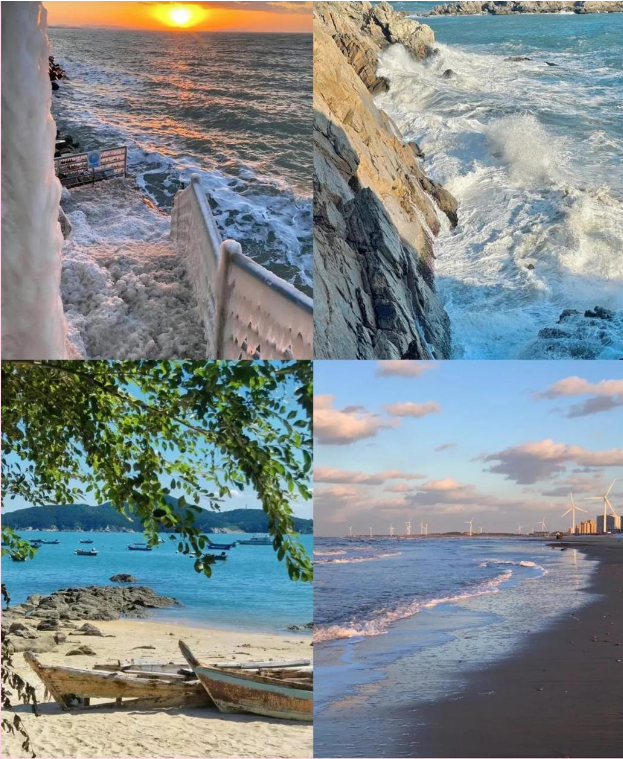| 当前位置:首页 |
|
|
外籍人士就业—自然气候 |
||||
|
|
||||
|
||||
|
The climate type of Weihai is a temperate monsoon climate, characterized by distinct seasons, rain and heat in the same season, mild climate throughout the year sufficient sunshine, and moderate rainfall, suitable for the growth of crops.威海的气候类型是温带季风气候,其特点是四季分明,雨热同季,全年气候温和,光照充足,雨量适中,适宜农作物生长。 The annual average temperature in Weihai is about 12℃, with a mild winter and cool summer, distinct seasons, the lowest temperature in winter is -5℃, the highest temperature in summer is about 30℃, and the annual precipitation is between 600-800 millimeters, humid and pleasant.威海全年平均气温在12℃左右,冬季温和,夏季凉爽,四季分明,冬季更低气温在-5℃左右,夏季更高气温在30℃左右,全年降水量在600-800毫米之间,湿润宜人。
Spring Characteristics (March to May) Spring features increasingly active warm air masses while cold air retains significant influence, resulting in variable weather. Between April and May, alternating northerly and southerly winds make these months the year’s windiest and strongest. Limited northward transport of warm, moist air contributes to relatively low precipitation—only 14% of the annual total. Frequent strong winds, low rainfall, and high evaporation rates often cause spring droughts. 春季(3月至5月)暖空气逐渐活跃,然而冷空气仍保持相当势力,导致多变的气候。在4月至5月间,南北大风交替出现,成为全年大风频繁、强度较高的月份。由于暖湿空气尚未能大量输送至该地区,因此降水量相对较少,仅占年总降水量的14%。同时,由于大风天气多且降水量小,蒸发量大,春季常常遭受旱情的困扰 Summer Characteristics (June to August) Oceanic moderation gives Weihai cooler summers. From June to July, temperatures run 3–4°C lower than inland areas at the same latitude; by August, this gap narrows to 1°C. This mildness establishes Weihai as a renowned summer retreat. Note: August sees the year’s highest monthly average temperatures. Extreme annual highs typically occur in July/August. Pacific typhoons moving northward often bring torrential rain and gales. 夏季(6月至8月)受海洋调节,威海市温度偏低。具体而言,6月至7月间,威海市的温度比内陆同纬度地区低3至4℃,而到了8月份,这一差距缩小至1℃。这样的凉爽气候使得威海市成为众所周知的避暑胜地。值得注意的是,威海市8月份的温度为全年最高,而年极端最高温度则出现在7月和8月。此外,太平洋台风北上时,往往会给威海市带来暴雨和大风天气。 Autumn Characteristics (September to November) Early autumn sees active cold air from the north clashing with residual warm, moist air, causing frequent rainfall—sometimes prolonged drizzle—in early September, occasionally influenced by typhoons. By October, conditions shift to predominantly clear, crisp days with excellent visibility, though autumn droughts may occur. From mid-November, the strengthening Mongolian High spurs more frequent cold air incursions. Temperatures drop sharply by ≈3°C per ten-day period, northerly winds intensify, and winter monsoon patterns emerge. 秋季(9月至11月)初,北方冷空气开始显现活跃,而暖湿空气尚存一定优势,因此9月上旬降雨依旧频繁,有时甚至出现连绵阴雨的天气,同时也有台风带来的影响。进入10月份后,天气多以晴朗为主,秋高气爽,阳光明媚,能见度极佳,但此时也容易出现秋旱现象。自11月中旬开始,强大的蒙古高压逐渐建立,冷空气活动趋于活跃,每旬气温以3℃的幅度迅速下滑,同时北向大风天气增多,冬季季风特征逐渐显现。 Winter Characteristics (December to February) Dominance by the powerful Mongolian High brings frequent cold air outbreaks, creating dry, cold conditions with prevailing northerly winds. January is the coldest month. Extreme annual lows typically occur in January/early February. Despite this, winter temperatures average 2°C higher than inland areas at the same latitude, with smaller diurnal variations. From late December, maritime effects increase localized overcast/snowy days. Precipitation here exceeds inland areas by over threefold, while sunshine duration decreases. 冬季(12月至2月)受到强大蒙古高压的支配,冷空气频繁南下,带来干燥寒冷的气候,多以偏北风为主。1月份成为全年最寒冷的月份,而年极端最低温度通常出现在1月或2月上旬。尽管如此,整个冬季的温度却比内陆同纬度地区高出2℃,且昼夜温差相对较小。自12月下旬开始,由于海洋的影响,地方性的阴天和雪天逐渐增多,雨雪量超过内陆同纬度地区的3倍以上,同时日照时间也相对减少。 |
||||
| 打印本页 关闭窗口 |
